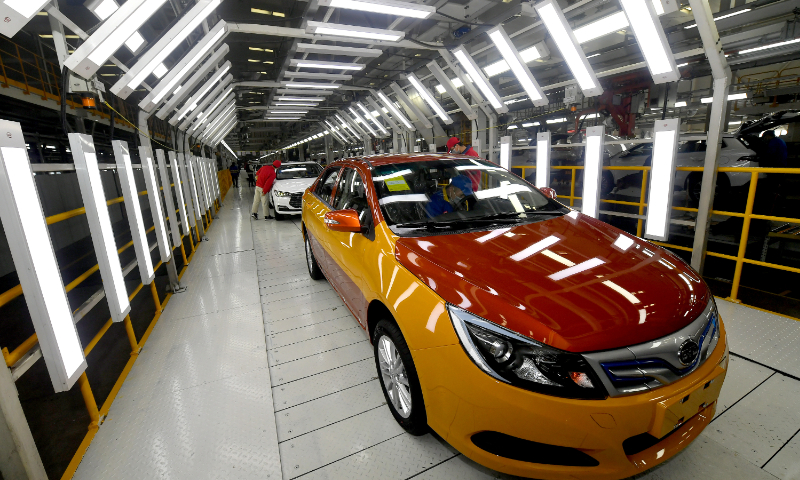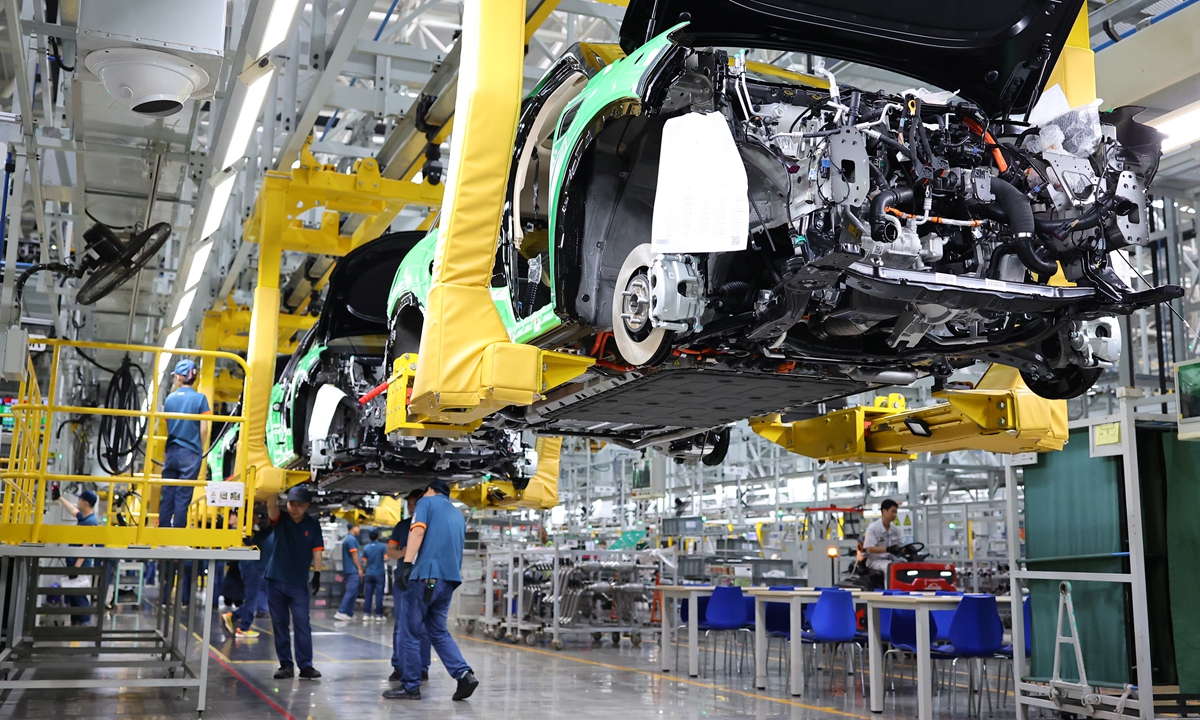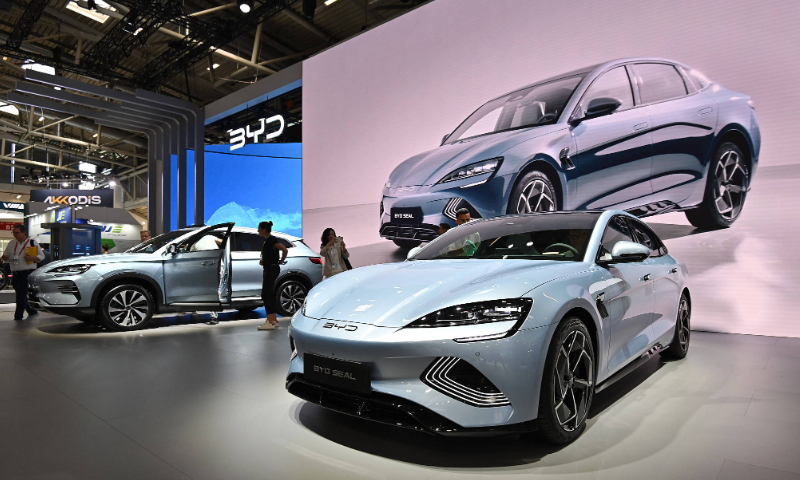BYD overtakes Tesla in quarterly EV sales, reflecting China’s rapid industrial upgrade
Firm’s rapid rise underlines success of China’s industrial upgrading: experts
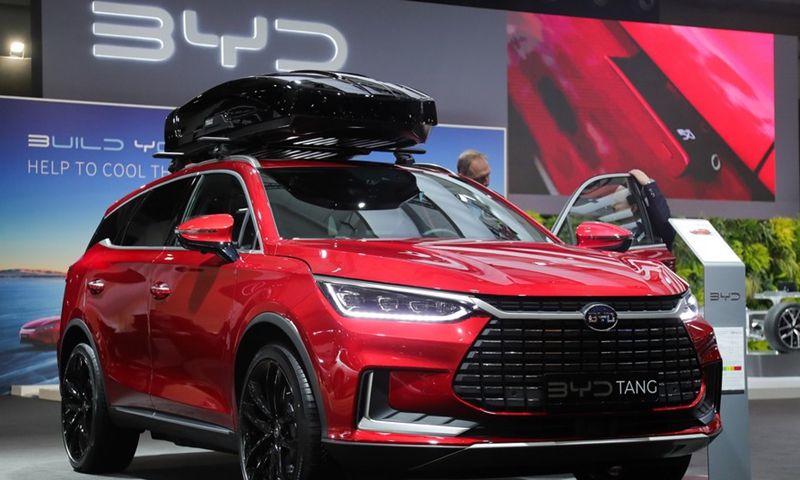
A man looks at a BYD Tang during the press day of the 100th Brussels Motor Show in Brussels, Belgium, Jan. 13, 2023.Photo:Xinhua
Chinese electric vehicle (EV) producer BYD Co overtook US-based Tesla Inc to become the world's biggest EV maker in the fourth quarter of 2023 for the first time, according to latest data from the companies. This had added another milestone to a historical year for China's auto industry as it's poised to propel China to become the world's biggest auto exporter.BYD's success, which also include an impressive growth rate throughout 2023 that outpaced Tesla and other EV makers, is a microcosm of the achievement in China's upgrade of its vast manufacturing industry, export sector and the domestic market - all crucial to China's high-quality development, experts said.
On Tuesday US time, Tesla said that it delivered 484,500 EVs in the final quarter of 2023, which also marked a new record for the company. However, that means BYD, which said on Monday that it had sold about 526,400 EVs during the same period, overtook Tesla to become the world's biggest EV maker in the fourth quarter of the year for the first time.
For the whole year of 2023, Tesla retained its spot as the biggest EV maker, as it delivered a total of 1.8 million EVs, larger than BYD's total sales of about 1.57 million units. Still, BYD's recorded a year-on-year sales growth rate of 73 percent for 2023, far outpacing Tesla's sales growth of 38 percent. Such sales growth rate has also led many to speculate that BYD will surpass Tesla to become the world's biggest EV maker in 2024.
This is also significant considering that BYD's market capitalization, at 573.17 billion yuan ($80.21 billion) as of Wednesday, represents only a fraction of Tesla's $778.42 billion. Over the past six months, BYD's shares dropped by 28.85 percent, while Tesla's shares fell by 11.22 percent.
Despite such a huge gap in the financial market, analysts expect that BYD is well positioned to maintain its lead in EV sales in 2024 over Tesla.
Hu Qimu, a deputy secretary-general of the digital-real economies integration Forum 50, said BYD's success is due to a slew of factors, including its own technological innovation, major policy support for industrial upgrading, a complete and stable domestic supply chain - which all helped BYD to make high-quality but affordable EVs.
"Given all these factors, it is no wonder that BYD surpasses Tesla," Hu told the Global Times on Wednesday.
In a statement it sent to the Global Times, BYD noted that it has grown to be the world's biggest EV company, and since its passenger car export strategy in May 2021, it has exported to 58 countries and regions around the world.
"Going forward, BYD will continue to promote the overseas expansion of passenger cars and continue to accelerate the global expansion of new-energy passenger cars," the company said.
BYD's milestone also came as China's whole EV sector saw a bumper year in 2023. According to the latest data from the China Association of Automobile Manufactures, in the first 11 months of 2023, China's exports of new-energy vehicles jumped 83.5 percent year-on-year to 1.09 million units. Thanks to such rapid growth, China's total auto exports reached 4.41 million units, up 58 percent year-on-year and outnumbering Japan's 3.99 million units during the same period.
This also represents a landmark event for China's auto industry as it becomes the world's biggest auto exporter after surpassing Japan in 2023 and Germany in 2022 - two countries that had been dominating the world's auto market for decades.
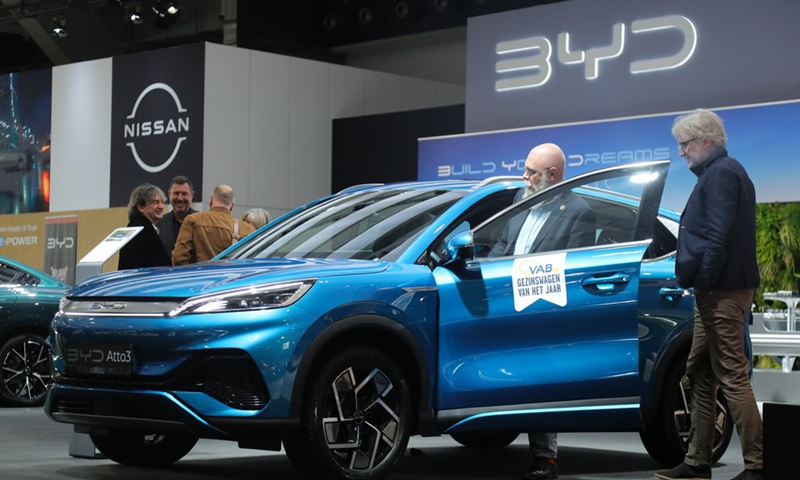
Visitors experience a BYD Atto 3 during the press day of the 100th Brussels Motor Show in Brussels, Belgium, Jan. 13, 2023.(Photo:Xinhua)
Industrial upgrading
The success of BYD as well as the whole Chinese EV sector directly reflect solid progress China has made in relentlessly pushing for industrial upgrade and high-quality development, experts said.
Cui Dongshu, secretary general of China Passenger Car Association, said BYD and other Chinese EV makers have benefited greatly from China's vast domestic market as well as the country's efforts to boost industrial transformation and upgrade.
"The biggest factor behind Chinese EV's success is the technological transformation. In addition, the Chinese market also offered a huge advantage for them to grow," Cui told the Global Times on Wednesday, noting that China's auto industry, especially the EV sector, has seen relatively better growth than other countries around the world thanks to China's policy supports.
For its success, BYD also pointed to various policies, including China's continued reform and opening-up, support for private businesses and the building of a new development model.
"Looking back, we feel more and more strongly that it was the reform and opening-up that gave birth to BYD, and it was the new development concept that created huge opportunities that strengthened BYD," the company said in the statement.
Policy support for the EV sector is just part of China's broader effort to transform and upgrade its industrial system, which has become a top priority in the pursuit of high-quality development. The Central Economic Work Conference held in December, which set priorities for economic work for 2024, listed the development of a modern industrial system led by innovation as a top priority.
Hu said that China's industrial transformation and upgrade has made great strides. "Through industrial transformation and upgrade, our international competitiveness is also strengthening and in terms of the macroeconomic situation, all three main drivers have been revitalized," he said.
One example of industrial upgrade revitalizing China's main economic drivers is the exports of EVs. Lithium batteries and solar panels became a highlight of China's exports in 2023, and they have been described as "the new three items" of China's exports sector, a drastic shift from the previous "three items" of China's exports - clothes, furniture and electronics.
In the first three quarters of 2023, total exports of "the three new items" jumped by 41.7 percent year-on-year, compared to a mere 0.6 percent in China's total exports during the period due to weak external demand.


